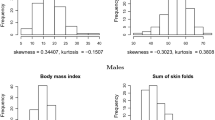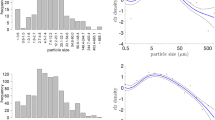Abstract
Estimation of product distributions of two factors was simulated by conventional Monte Carlo techniques using factor distributions that were independent (uncorrelated). Several simulations using uniform distributions of factors show that the product distribution has a central peak approximately centered at the product of the medians of the factor distributions. Factor distributions that are peaked, such as Gaussian (normal) produce an even more peaked product distribution. Piecewise analytic solutions can be obtained for independent factor distributions and yield insight into the properties of the product distribution. As an example, porphyry copper grades and tonnages are now available in at least one public database and their distributions were analyzed. Although both grade and tonnage can be approximated with lognormal distributions, they are not exactly fit by them. The grade shows some nonlinear correlation with tonnage for the published database. Sampling by deposit from available databases of grade, tonnage, and geological details of each deposit specifies both grade and tonnage for that deposit. Any correlation between grade and tonnage is then preserved and the observed distribution of grades and tonnages can be used with no assumption of distribution form.

















Similar content being viewed by others
References
Abramowitz, M., & Stegun, I. A. (1964). Handbook of mathematical functions with formulas, graphs, and mathematical tables. New York: Dover. http://people.math.sfu.ca/cbm/aands/intro.htm.
Acton, F. S. (1966). Analysis of straight-line data. New York: Dover.
Bardossy, G., & Fodor, J. (2001). Traditional and new ways to handle uncertainty in geology. Natural Resources Research, 10, 179–187. http://www.ingentaconnect.com/content/klu/narr/2001/00000010/00000003/00361267.
Bardossy, G., & Fodor, J. (2004). Evaluation of uncertainties and risks in geology: New mathematical approaches for their handling. Berlin: Springer.
Bultman, M. W., Force, E. R., Gettings, M. E., & Fisher, F. S. (1993). Comments on the “three-step” method for quantification of undiscovered mineral resources. Technical Report, Open-File Report 93-23, U.S. Geological Survey Open-File Report 93-23.
Bultman, M., & Gettings, M. (1996). Quantitative mineral resource assessment of Coronado National Forest, Chap J. In Mineral resource potential and geology of Coronado National Forest, Southeastern Arizona and Southwestern New Mexico (pp. 183–202). U. S. Geological Survey, Bulletin 2083-A.
Carranza, E., & Hale, M. (2001). Geologically constrained fuzzy mapping of gold mineralization potential, Baguio District, Philippines. Natural Resources Research, 10(2), 125–136.
Cleveland, W. (1979). Robust locally weighted regression and smoothing scatterplots. Journal of the American Statistical Association, 74(368), 829–836. doi:10.2307/2286407.
Cox, D. P., Singer, D. A., et al. (1986). Mineral deposit models. No. 1693 in U.S. Geological Survey Bulletin, U.S. Geological Survey. http://pubs.usgs.gov/bul/1693/report.pdf.
Dohm, C. (2005). Quantifiable mineral resource classification: A logical approach. In: O. Leuangthong & C. V.Deutsch (Eds.), Geostatistics banff 2004, Quantitative geology and geostatistics (Vol. 14, pp. 333–342). Dordrecht: Springer. doi:10.1007/978-1-4020-3610-1:34.
Dubois, D. (2009). Uncertainty theories: A unified view. In IEEE Conference on Cybernetic Systems, Dublin, p. 6.
Dubois, D., & Prade, H. (1988). Possibility theory: An approach to computerized processing of uncertainty. New York: Plenum Press.
Dubois, D., & Prade, H. (2007). Possibility theory. Scholarpedia, 2(10):2074.
Eckhardt, R. (1987). Stan Ulam, John von Neumann, and the Monte Carlo method. Los Alamos Science, 15, 131–136.
Ferson, S. (1996). What Monte Carlo methods cannot do. Human and Ecological Risk Assessment, 2, 990–1007.
Ferson, S., & Long, T. (1995). Conservative uncertainty propagation in environmental risk assessments. InEnvironmental toxicology risk assessment (Vol. 3, pp. 97–110), ASTM STP 1218.
Fisher, B. (1971). The product of distributions. The Quarterly Journal of Mathematics, 22(2), 291–298. doi:10.1093/qmath/22.2.291. http://qjmath.oxfordjournals.org/content/22/2/291.full.pdf+html.
Fishman, G. S. (1995). Monte Carlo: Concepts, algorithms, and applications. New York: Springer. ISBN 038794527X.
Förster, S. (1997). Monte Carlo simulation of correlated random variables. Available online at http://citeseerx.ist.psu.edu/viewdoc/download?doi=10.1.1.27.7289.pdf, 7 p.
Frenkel, D. (2004). Introduction to Monte Carlo methods. In Computational soft matter: From synthetic polymers to proteins, Lecture Notes, NIC Series (Vol. 23, pp. 29–60). John von Neumann Institute for Computing, Julich.
Gettings, M. (2009). Identification of concealed lithologies using possibility theory and aeromagnetic data. In: P. Williams, et al. (Eds.), Smart Science for Exploration and Mining, Proceedings of the 10th Biennial SGA Meeting of The Society for Geology Applied to Mineral Deposits, Townsville, 17th–20th August 2009, M. Gettings (Ed.), Session C4: Finding Resources Under Cover: New Geophysical and Imaging Techniques for Exploration (pp. 796–798).
Gettings, M. E., & Bultman, M. W. (1993). Quantifying favorableness for occurrence of a mineral deposit type using fuzzy logic—An example from Arizona. Technical Report, Open-File Report 93-392, U.S. Geological Survey Open-File Report 93-392.
Gettings, M. E., Bultman, M. W., & Fisher, F. S. (2004). A complex systems model approach to quantified mineral resource appraisal. Environmental Management, 33, 87–98. doi:10.1007/s00267-003-2835-7.
Glen, A. G., Leemis, L. M., & Drew, J. H. (2004). Computing the distribution of the product of two continuous random variables. Computational Statistics & Data Analysis, 44(3), 451–464. http://ideas.repec.org/a/eee/csdana/v44y2004i3p451-464.html.
Green, B. (2009). Review of additive combinatorics. Bulletin of the American Mathematical Society, 46, 487–497.
Haugh, M. (2004). The Monte Carlo framework, examples from finance and generating correlated random variables, Lecture Notes. New York: Columbia University.
Iman, R., & Conover, W. (1982). A distribution-free approach to inducing rank correlation among input variables. Communications in Statistics—Simulation and Computation, 11(3), 311–334.
Laba, I. (2008). From harmonic analysis to arithmetic combinatorics. Bulletin of the American Mathematical Society, 45, 77–115.
Metropolis, N., & Ulam, S. (1949). The Monte Carlo method. Journal of the American Statistical Association, 44(247), 335–341. doi:10.1080/01621459.1949.10483310.
Press, F. (1968). Earth models obtained by Monte Carlo inversion. Journal of Geophysical Research, 73(16), 5223–5234. doi:10.1029/JB073i016p05223.
R Development Core Team. (2008). R: A language and environment for statistical computing. Vienna: R Foundation for Statistical Computing. http://www.R-project.org, ISBN 3-900051-07-0.
Robert, C. P., & Casella, G. (2004). Monte Carlo statistical methods (2nd ed.). New York: Springer. ISBN 0387212396
Robert, C. P., & Casella, G. (2010). Introducing Monte Carlo methods with R (2010th ed.). New York: Springer.
Rohatgi, V. (1976). An introduction to probability theory mathematical statistics. New York: Wiley.
Roisenberg, M., Schoeninger, C., & da Silva, R. R. (2009). A hybrid fuzzy-probabilistic system for risk analysis in petroleum exploration prospects. Expert Systems with Applications, 36(3), 6282–6294. doi:10.1016/j.eswa.2008.07.060.
Root, D. H., Menzie, W. D., & Scott, W. A. (1992). Computer Monte Carlo simulation in quantitative resource estimation. Natural Resources Research, 1, 125–138. doi:10.1007/BF01782266.
Ross, S. (1997). A first course in probability (5th ed.). Upper Saddle River, NJ: Prentice Hall.
Singer, D., Berger, V., & Moring, B. (2008). Porphyry copper deposits of the world: Database, map, and grade and tonnage models, 2008. US Geological Survey Open-file Report 20081155 N/A:N/A. http://pubs.usgs.gov/of/2008/1155/.
Souza, L. E., Costa, J. F. C. L., & Koppe, J. C. (2005). Measures of uncertainty for resource classification. In: O. Leuangthong & C. V. Deutsch (Eds.), Geostatistics banff 2004, Quantitative geology and geostatistics (Vol. 14, pp. 529–536). Dordrecht: Springer. doi:10.1007/978-1-4020-3610-1:53.
Stylios, C. D., & Groumpos, R. P. (2004). Modeling complex systems using fuzzy cognitive maps. IEEE Transactions on Systems, Man, and Cybernetics, Part A: Systems and Humans, 34(1), 155.
Szolovits, P., & Pauker, S. G. (1978). Categorical and probabilistic reasoning in medical diagnosis. Artificial Intelligence, 11, 115–144.
Tangestani, M. H., & Moore, F. (2003). Mapping porphyry copper potential with a fuzzy model, northern Shahr-e-Babak, Iran. Australian Journal of Earth Sciences, 50(3):311–317. doi:10.1046/j.1440-0952.2003.00991.x.
Thode, H. (2002). Testing for normality. Statistics: A series of textbooks and monographs. New York: Marcel Dekker. http://books.google.com/books?id=gbegXB4SdosC.
Tucker, W. T., & Ferson, S. (2003). Probability bounds analysis in environmental risk assessments. Technical Report, Applied Biomathematics, Setauket, New York.
Tutmez, B. (2007). An uncertainty oriented fuzzy methodology for grade estimation. Computers & Geosciences, 33(2), 280–288. doi:10.1016/j.cageo.2006.09.001.
Tutmez, B., Tercan, A., & Kaymak, U. (2007). Fuzzy modeling for reserve estimation based on spatial variability. Mathematical Geology, 39, 87–111. doi:10.1007/s11004-006-9066-4. http://www.ingentaconnect.com/content/klu/matg/2007/00000039/00000001/00009066.
Williamson, R., & Downs, T. (1990). Probabilistic arithmetic. I: Numerical methods for calculating convolutions and dependency bounds. International Journal of Approximate Reasoning, 4, 89–158.
Yamane, T. (1967). Statistics, an introductory analysis (2nd ed.). New York: Harper & Row.
Zadeh, L. A. (1965). Fuzzy sets. Information and Control, 8, 338–353.
Author information
Authors and Affiliations
Corresponding author
Rights and permissions
About this article
Cite this article
Gettings, M.E. Monte Carlo Simulations of Product Distributions and Contained Metal Estimates. Nat Resour Res 22, 239–254 (2013). https://doi.org/10.1007/s11053-013-9206-8
Received:
Accepted:
Published:
Issue Date:
DOI: https://doi.org/10.1007/s11053-013-9206-8




